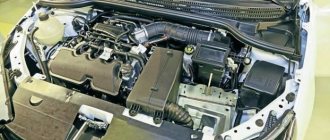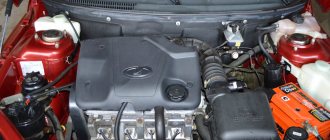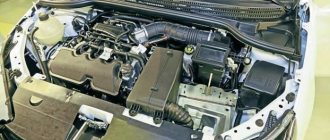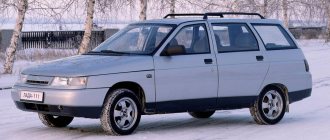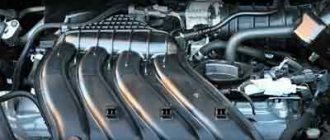Description
The VAZ-21179 engine, created and put into production in 2016, was significantly different from its predecessors. First of all, the increased working volume. The elements of the connecting rod and piston group, timing, lubrication and cooling systems have received significant changes.
The VAZ-21179 is a four-cylinder in-line naturally aspirated petrol engine with a volume of 1.8 liters and a power of 122-145 hp. s and torque 170-184 Nm.
Installed on VAZ cars:
- Lada Vesta 2180 and SV 2181 (2016-2021);
- Lada Vesta Cross 2180 (2018-2021);
- Lada Vesta Sport 2180 (2018-2021);
- Lada X-ray (2015-2021);
- Lada X-ray Cross (2018-2021).
Additionally, it was planned to install this engine on other VAZ models (Largus, Kalina-2, Granta and Lada 4x4 NG), but the projects were not implemented.
The cylinder block is traditionally made of cast iron. The basis for the development was a block from the VAZ-21126. The improvements included the manufacture of an additional oil channel for lubrication of the valve timing control, improved cooling of the inter-cylinder jumpers and changes in the fastening of the bracket for the right engine support.
The engine crankshaft has undergone changes. The crank radius was increased to 42 mm instead of the previous 37.8, which affected the piston stroke. Now it has become 84 mm (was 75.6). To reduce friction, the diameter of the connecting rod journals has been reduced by four millimeters.
The lubrication of the main bearings began to be carried out according to a new scheme.
The pistons are standard, aluminum, with three rings, two of which are compression, one oil scraper (chrome-plated).
The connecting rods are shortened and interchangeable. Delivered from India.
The cylinder head has received significant improvements. Camshafts (2 pcs.) – composite design. Pressed cams (powder metallurgy). A valve timing regulator (phase shifter) is mounted on the intake camshaft. The head is installed on a metal gasket.
The intake module has also been modified - instead of the mass air flow sensor, temperature and absolute pressure sensors have been installed. In addition, an additional receiver with a system for changing the length of the air path was removed from the design.
The cooling system uses a pump from a Korean manufacturer (GMB). Overall, engine cooling has become more efficient.
The lubrication system is slightly increased in volume and has an oil pump with increased performance (like a water pump - from GMB). Aluminum crankcase, cast.
A more complete list of changes is presented in the figure.
Main changes in the VAZ-21179 engine
Timing belt drive. The service life determined by the manufacturer is 180 thousand km. It must be remembered that if the drive belt breaks, the meeting of the valves with the piston is inevitable. The result is predictable - bent valves and a destroyed piston.
Despite innovative solutions in the design of internal combustion engines, the final result turned out to be far from what was planned, much less from the ideal.
The main “disease” of the engine is oil burning. There have been cases when it exceeded 3 liters. per 1000 km. mileage VAZ engine builders have repeatedly tried to solve this problem, but the attempts were unsuccessful.
Experts attribute the increased oil consumption to design flaws in the development of the power unit.
Firstly, the height of the cylinder block remained the same, but the connecting rods were shortened. As a result of this decision, the speed of movement of the pistons increased with a simultaneous increase in load.
Secondly, the quality of the valves is very low (they are supplied from China).
Thirdly, as a result of the manufacturer’s shortcomings, there are errors in the incorrectly designed lubrication scheme of the crankshaft-main liner assembly (the groove on the liner is less than 180°, and there are no counter grooves in the yokes at all).
Additionally, this may include the low quality of control during engine assembly (there are cases of increased gaps in the CPG).
The oil burn problem is eliminated by boring the block to the next repair size and replacing the pistons and rings. In other words, the engine needs a complete overhaul regardless of its mileage.
Advantages
The motor was developed almost from scratch, so it received a fairly large number of positive qualities. Owners of cars driven by this engine note quite interesting solutions from manufacturers:
- Engineers increased the torque, but they managed to increase it not only at high but also at low speeds. This made it possible to guarantee optimal dynamics not only for driving in the city, but also outside the city.
- The oil pump began to work twice as hard as before, and the weight of the camshafts was reduced and the cross-section of the valves was increased. This made it possible to achieve the maximum guarantee of normal lubrication, which entails an increase in service life.
- In order to meet Euro 5 emissions standards, manufacturers had to improve the intake and exhaust manifolds. This is a rather interesting solution, since the car emits few harmful substances into the environment during operation.
- If necessary, repairing the VAZ 21179 engine will not require large expenses from the owners. Since almost all elements of the power unit are manufactured in Russia, the availability of components is good, and they are inexpensive.
Specifications
| Manufacturer | Concern "AvtoVAZ" |
| Start year of release | 2016 |
| Volume, cm³ | 1774 |
| Power, l. With | 122-145 |
| Torque, Nm | 170-184 |
| Compression ratio | 10.3 |
| Cylinder block | cast iron |
| Number of cylinders | 4 |
| Fuel injection order | 1-3-4-2 |
| cylinder head | aluminum |
| Cylinder diameter, mm | 82 |
| Piston stroke, mm | 84 |
| Number of valves per cylinder | 4 (DOHC) |
| Timing drive | belt |
| Turbocharging | No |
| Hydraulic compensators | There is |
| Valve timing regulator | VVT, 1 (intake) |
| Lubrication system capacity, l | 4.4 |
| Oil used | 5W30, 5W40, 10W30, 10W40 |
| Fuel supply system | injector |
| Fuel | gasoline AI-92 |
| Environmental standards | Euro 5 |
| Resource, thousand km | 220 |
| Location | transverse |
| Weight, kg | 110 |
| Tuning (potential), l. With | 150 |
GC1–6
The crankshaft has an increased crank radius.
The working volume of the cylinders has increased due to the larger piston stroke. The crankshaft has an increased crank radius. The working volume of the cylinders has increased due to the larger piston stroke.
Adjusting the phases required upgrading the lubrication system. Main bearings with an oil distribution groove of variable cross-section are installed to reduce oil consumption. For the first time, a foreign-made oil pump appeared on a VAZ engine - the South Korean GMB. The productivity of domestic pumps is 34–38 l/min at an engine speed of 6000 rpm, and GMB produces 54–60 liters. The pump body is aluminum, not cast iron. The cross-section of the oil intake is, of course, increased. The aluminum engine sump has a flange to mate with the clutch housing, which increases the rigidity of the power unit. The oil sump volume is 4.4 liters versus 3.2 liters for the 1.6 engine.
The water pump is also Korean, with high-quality bearings and seals that guarantee reliability. It is better than the serial VAZ ones: among other things, higher performance. The plastic intake module is made by the Tolyatti company Motor-Super. The gas-dynamic characteristics of the intake tract are optimized for the new engine. The developed fins of the module made it possible to reduce noise. The engine control system does not work with mass air flow readings, but calculates parameters through temperature and pressure. Therefore, the intake module has a slot for the corresponding sensor.
Reliability, weaknesses, maintainability
Reliability
The issue of reliability of the VAZ-21179 has always caused controversy among car owners. It was not possible to reach a common opinion.
The manufacturer has made several attempts to increase the reliability of the internal combustion engine. Unfortunately, they did not lead to the expected result. As noted, the main problem with this engine was high oil consumption. The main ways to solve this problem were chosen:
- changing the valve timing control calibration;
- contacting valve suppliers to improve the quality of supplied products;
- changes in the manufacturing technology of valve stem seals;
- replacing 5W30 oil with a more viscous one;
- changing the design of the oil deflector.
A huge amount of work has been done in these areas, but has yielded virtually no results. Car enthusiasts write about this in their comments on forums. So, Xotab_555 o. And such reviews are not isolated.
At the same time, it is noted that some engines lasted 300-350 thousand km without breakdowns or deviations in oil consumption. But, judging by the reviews, this applies to those engines that have undergone a major overhaul with the replacement of the piston group and boring of the cylinders.
The general conclusion is not comforting - the reliability of the VAZ-21179 engine is extremely low.
Weak spots
There are not so many of them, but they are significant. Increased oil consumption has already been mentioned. Another problem that often occurs in the lubrication system is the oil pump pressure relief valve jamming in the open position.
The main reason for the phenomenon is contamination of the working surface with combustion products and the use of contaminated oil.
Oil leaks through seals. Eliminated by replacing seals or gaskets. Sometimes it's enough just to tighten them a little more.
The occurrence of knocking noises when the engine is not warmed up. In most cases, the “authors” are hydraulic compensators. This is not fatal, but in this case it would not be superfluous to have the engine diagnosed at a specialized service station - there are many reasons for the appearance of knocking noises.
The electrics of the unit also cause a lot of complaints. Particularly annoying is the regular appearance of the “Check Engine” icon on the dashboard. Often, immediate computer diagnostics of the engine in this case does not detect any deviations in the operation of the engine systems.
Low quality of parts supplied for assembly by importers, especially from China.
Other malfunctions that sometimes occur in the unit are not critical.
Problems
Not only reviews about the VAZ 21179 engine, but also its production cycle (it was produced in a very short time), indicate that this was not the most successful option for manufacturers. The main problems faced by owners are the following:
- Unfortunately, the power unit is characterized by increased consumption of lubricating fluid. There are quite a large number of opinions about the causes of oil burns. But most likely this is due to design features, since increased oil consumption can be overcome by boring the cylinders and achieving normal piston clearances.
- The oil pump in this internal combustion engine often jams, and the main reason that the pressure relief valve remains in the open position is the adhesion of combustion products on it. It is worth closely monitoring the lubricant pressure, since a drop in it can affect very rapid wear of the camshaft and crankshaft journals.
- There are also other breakdowns in the form of regular oil leaks from the camshaft plugs. Also, sometimes the fuel supply pipe can rub against the partition bracket, which can lead to a fire. The timing belt also often breaks.
Available body types
Largus owner reviews all cons
Reviews about the characteristics of the Lada Vesta create a pleasant impression. Many car enthusiasts have the feeling that we are not talking about the products of the more than once disgraced AvtoVAZ, but about a solid, brand new budget-class foreign car.
It is worth noting that at this stage the Lada Vesta sedan, the characteristics of which have already amazed the public, is the only mass-produced body type. AvtoVAZ facilities will be ready to produce a hatchback of this model by the end of spring 2016, and the model after restyling will undergo all kinds of test drives and will be released for sale only by the fall.
The best news is saved for last. The technical characteristics of the Lada Vesta station wagon promise to become something qualitatively different and superior to the capabilities of a sedan and hatchback. Information about the exact performance of this model is not yet available, but work on creating a Vesta of this type is already underway at the concern. It is worth noting that the plant management promises to make this station wagon a real crossover: the characteristics of the Lada Vesta will fully correspond to this title. According to experts, we should expect higher fuel consumption and more power from the standard engine that powers all-wheel drive, as well as independent soft suspension. In this case, the station wagon risks becoming a real pearl of AvtoVAZ, and such success can overshadow past failures. Unfortunately, it is currently not possible to find out anything about the characteristics of the Lada Vesta Cross, but the release of the crossover is planned immediately after the release of the hatchback.
Video of engine assembly 1.8 Lada Vesta Cross
What is the most important thing in a car? Wheels, interior, and maybe suspension - We believe that when choosing a car, everything is important. But the engine is the most important factor when deciding to buy a car. The Lada Vesta is powered by 3 modern engines from AvtoVAZ. Any car enthusiast would be curious to know in detail about each of them.
In total, the review material will consider three main types of engine:
— engine 21129 from VAZ — technical problems, characteristics; — 21179 from VAZ — the new top-end 1.8 engine is installed on the latest modifications, including the Lada Vesta SW Cross; The HR16DE-H4M propulsion system from Nissan is a chain motor with an impressive resource, but manual valve adjustment.
Size marking
For clarity, let’s read the inscription on the standard Lada XRay tire, for example: 195/65 R15. It means that the tire has the following dimensions:
- 195 – tire width in millimeters;
- 65 – tire profile height as a percentage of its width;
- 15 – disk size in inches.
The most incomprehensible quantity here is usually the profile height. In fact, it is not difficult to calculate it by converting it into understandable units: divide 195 by 100 and multiply by 65. The result is 126.75 millimeters.
It should be noted that low-profile “rubber” is considered if its height is less than 50% of the width. When independently choosing the size you require, keep in mind that a deviation of a value of up to 3 mm will not cause noticeable adverse consequences, and its value of 6 mm and above is simply unacceptable.
What kind of engine oil should I fill in the 1.8 engine of the Lada Vesta Cross SV 2022?
In order to answer the question “What kind of oil to pour into the 1.8 engine of the Lada Vesta Cross 2017”, you need to understand under what conditions the car will be operated. First, let's define viscosity. In this case, AvtoVAZ in the operating instructions for the Lada Vesta SV recommends using the following SAE viscosities:
But not all viscosities are equally suitable. For example, if the machine is used in cold regions, then it is better to use thinner oils such as 5W-30 or 5W-40. Even 0W-40 oils can be used in new engines with low mileage.
If the car is used only in the warm season or in hot regions, then 10W-40 or even 15W-40 oils are perfect.
Convenience and speed
Lada Vesta is by no means considered the most comfortable car in its category - many foreign cars still surpass even the Luxury trim level in terms of their equipment. Another thing is that the ratio of price and characteristics of the Lada Vesta car makes this new brainchild of the AvtoVAZ concern a much more profitable purchase. In its price segment of budget cars, Vesta has no competitors: the price of the standard Classic configuration is a little over 500 thousand rubles, and the full Luxury configuration costs only a quarter more (625 thousand rubles) with functionality comparable to that of an expensive foreign car.
The trunk dimensions are quite impressive. It is very deep and very convenient, since the wheel arches of the body practically do not stand out inside the car. The working volume of the trunk is 450 liters - here Vesta also did not take the lead in its category, however, this figure is quite good.
As for speed, there is good news for those who like to drive. The technical characteristics of the Lada Vesta allow the car to accelerate to 185 km/h, while reaching 100 km/h in just ten and three tenths of a second. For a hatchback, naturally, slightly different aerodynamic conditions apply - however, its speed and acceleration will be quite good for a car in the budget price segment.
Signs of the need for internal combustion engine repair
The reasons why the operation of the engine is disrupted are arranged in a small list, starting with refusal to start and ending with floating idle speed (this problem was removed on the 127 “engine”). Not all breakdowns end in capital damage - sometimes it’s enough to add oil, sometimes it’s enough to adjust the ECU settings.
Compression reduction
A decrease in cylinder compression below 16 atmospheres is a bad sign. Such a high limit corresponds to a compression ratio of 11.
Knocks in the engine
Engine knocks can come from several points. These could be hydraulic compressors, timing belt rollers or pins. The knocking noise could also be caused by low oil level. The answer to the question will be given by a thorough detailed inspection of all parts of the unit and checking the oil level.
Blue smoke from the exhaust pipe
The blue smoke that comes from the exhaust pipe appears when oil enters the combustion chamber. It can leak either from the valves or from under the piston. The result is the same: the oil is eaten up and blue smoke pours out of the chimney. Once the leak is located, half the problem will already be solved.
Troit motor
Sometimes in the cold the engine may stall - don’t be alarmed by this, because it may simply be one of the spark plugs that fails. In this case, we advise you to simply restart the engine and it will stop running.
How much does it cost to overhaul a Priora engine - average price
Self-repair of a Priora engine with 16 valves costs an average of 16-20 thousand rubles. The cost depends on the severity of the breakdown and may be lower or higher than this average range. Repairing a Priora engine can be entrusted to the wrong hands, but then you will have to pay for the work - sometimes the cost of repairs reaches as much as 40 thousand rubles.
This is an unreasonably inflated figure, because, as practice shows, you can rebuild the engine on a Priora, working at a moderate pace, in just three days - and three days of work is definitely not worth that kind of money. Don’t be afraid of not being able to cope - your Lada is easy to repair, and using the advice and “tutorials”, you will conquer even such a task that is impossible at first glance.
Of course, for many experienced car owners, the question such as “whether the valves on a Priora are bent” has long been studied. But there are many new drivers who do not have information on this matter. It is for such car enthusiasts that this post will be written.
Development history
The history of the unit, which will become the top of the AvtoVAZ line in the near future, has gone through many events, ups and downs. But the most important stage of development began in 2006, when they started working on the engine in earnest. Then the plans of the main design bureau were to produce a completely new class of VAZ-2116 cars (also known as the “Silhouette” project, or “AvtoVAZ C-class”).
And, in fact, the VAZ-21179 was supposed to be the top of the line and installed (in addition to the Silhouette models) also on SUVs. However, the development was closed because management did not approve of the C-class, but later they returned to it with renewed vigor in 2008. Even then, it was decided to assemble a new unit based on the old 1.6-liter ones, since creating a completely new engine would cost a pretty penny. The result of research and reflection was the signing of a contract with the Ricardo concern, based in the UK and dealing with variable valve timing systems.
The influence of wheel sizes on a car
Profile height
Low-profile tires combined with larger wheels give the car a more attractive (“aggressive”) appearance. In addition, less weight of the wheels will increase the car's handling and stability. But, given the disgusting quality of roads in most regions of Russia, it is impractical to install such tires - when hitting the sharp edge of a pothole in the asphalt, they easily break through. And so much so that even a disk can be damaged.
Tire width
Installing wider tires will increase the car's grip on the road surface, but if the latter is rutting, the car will be more difficult to control. This is especially dangerous in winter, on slippery roads. In addition, cross-country ability and controllability will decrease when driving on loose snow. Wide tires also create more noise when driving and cause increased fuel consumption.
Disc offset
Disc offset is the distance from the landing plane to the outer plane of rotation of the wheel. Here it is generally undesirable to experiment and install disks that have an offset equal to the factory one.
In addition to the fact that installing discs with an increased offset can limit the angle of rotation of the wheel, the load on the wheel bearings will also increase. In addition, when driving on an uneven road, the suspension travel will increase, which will negatively affect its service life.
And, in conclusion, we can say that choosing “tires” for a car is always a search for a compromise between its different indicators and characteristics, and it is important to be able to set priorities – what do you expect from the car and under what conditions will it have to “rack up the mileage”. Lada X-Ray is a roomy 5-seater hatchback, representing a class of pseudo-crossovers that is extremely popular in Russia.
In 2012, at the Moscow Motor Show, the XRAY Concept car made a real splash, setting a fundamentally new tone in the development of the style of the domestic brand. It was this that became the basis for the creation of the model, which also premiered in Moscow. AvtoVAZ made the right decision – the start of sales of the pseudo-SUV turned out to be extremely successful
Lada X-Ray is a roomy 5-seater hatchback, representing the class of pseudo-crossovers that is extremely popular in Russia. In 2012, at the Moscow Motor Show, the XRAY Concept car made a real splash, setting a fundamentally new tone in the development of the style of the domestic brand. It was this that became the basis for the creation of the model, which also premiered in Moscow. AvtoVAZ made the right decision – the start of sales of the pseudo-SUV turned out to be extremely successful.
The debate about the Lada XRAY class continues to this day. The model is made in a hatchback body (class B), but due to its higher ground clearance, some experts classify it as an SUV. The list of competitors for the domestic product is extensive. This includes both budget Renault Sandero Stepway, Geely MK Cross, and more expensive Mitsubishi ASX and Nissan Juke in comparison with X-Ray.
Design nuances
The 21179 engine bears little resemblance to the basic version 21127, as both the design and appearance have changed:
- phasing of intake valves within ±30 degrees;
- hollow camshafts with cams using powder metallurgy;
- vortex air supply into the combustion chamber;
- cylinder cooling system (jacket);
- improved configuration and cylinder head gasket volumes;
- ShPG Federal Mogul;
- Korean pump;
- inclined drilling of oil channels in the crankshaft journals;
- polymer cylinder head cover and solid aluminum pan;
- flywheel for clutch 215 mm, which is recommended by the manufacturer.
Motor gaskets
ShPG from Federal Mogul
Cylinder block
If you look closely externally, you will notice almost complete similarity of the new unit with the old one, and this is true. But there is a difference, and it is simply colossal. The first difference is a new oil channel between the first two cylinders, duplicating the one located between cylinders two and three.
It is worth noting the presence of special V-shaped channels for cooling the cylinder jumper areas, which made it possible to eliminate wear of the rings in the early stages. A three-level classification of main bearing beds, crankshaft and liners was also added. At this stage, there is an interesting moment in selective assembly, when a special tracking device reads information about size classes from the cylinder block and crankshaft, and then signals the assembler about the need to install one or another liner. They also provided for the possibility of placing the VAZ-21179 on all-wheel drive vehicles.



